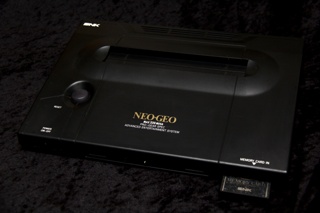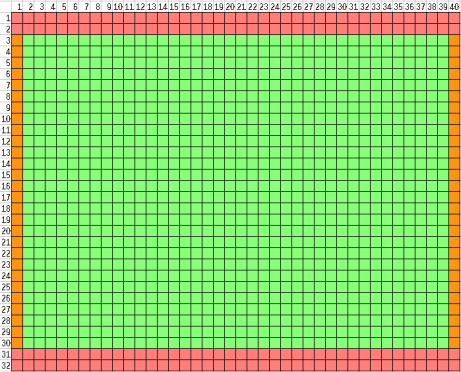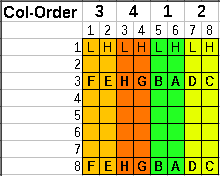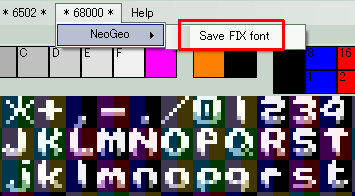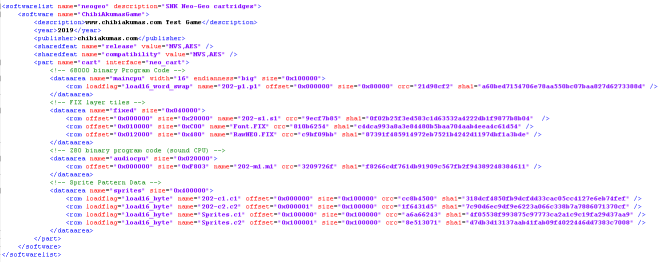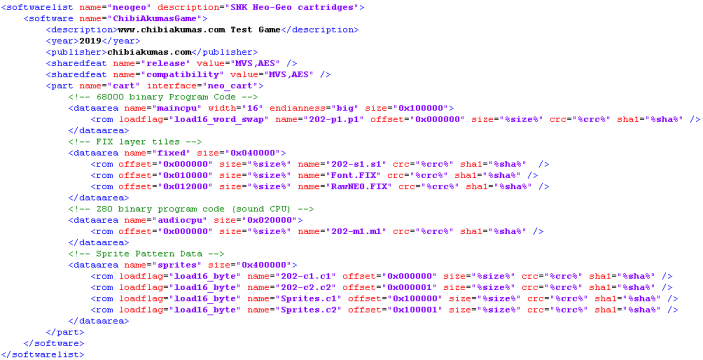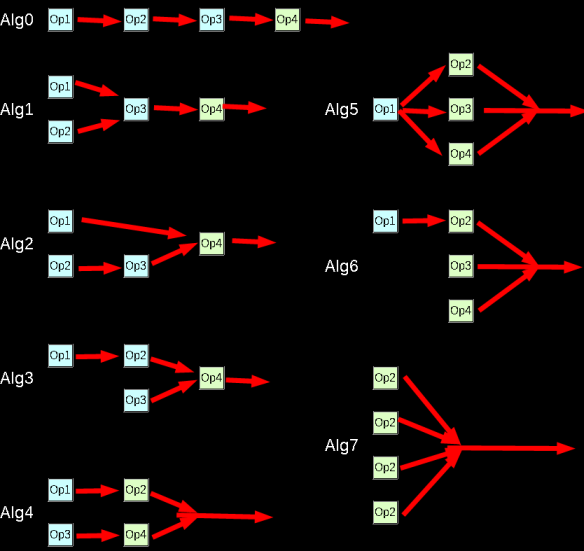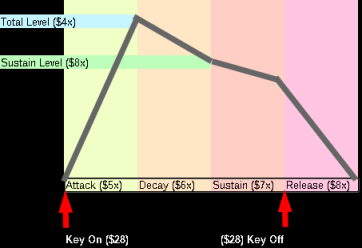| Function |
Port |
Details |
|
$000000 |
Vector
Table |
|
$000100 |
Cart
Header
and User Vectors |
|
$000400 |
1st
bank
of Rom |
|
$100000 |
Ram
(64k) |
| BIOS_SYSTEM_MODE |
$10FD80 |
(byte)
VBL
for $00=system,$80=game |
| BIOS_SYSRET_STATUS |
$10FD81 |
(byte)
Stores
function code for SYSTEM_RETURN |
| BIOS_MVS_FLAG |
$10FD82 |
(byte)
0=Home/AES,1=MVS |
| BIOS_COUNTRY_CODE |
$10FD83 |
(byte)
0=Japan,1=USA,2=Europe/Export
(xxx:Korea?) |
| BIOS_GAME_DIP |
$10FD84 |
$10FD84-$10FD93
(all
bytes) |
| BIOS_GAMEDIP_TIME1 |
$10FD84 |
(word)
timed
option 1 (minutes and seconds in BCD) |
| BIOS_GAMEDIP_TIME2 |
$10FD86 |
(word)
timed
option 2 (minutes and seconds in BCD) |
| BIOS_GAMEDIP_COUNT1 |
$10FD88 |
(byte)
counter
option 1 (1-99; value set here is default) |
| BIOS_GAMEDIP_COUNT2 |
$10FD89 |
(byte)
counter
option 2 (WITHOUT, INFINITE, 1-99 TIMES) |
| BIOS_GAMEDIP_01 |
$10FD8A |
(byte)
Game
soft dip 01 |
| BIOS_GAMEDIP_02 |
$10FD8B |
(byte)
Game
soft dip 02 |
| BIOS_GAMEDIP_03 |
$10FD8C |
(byte)
Game
soft dip 03 |
| BIOS_GAMEDIP_04 |
$10FD8D |
(byte)
Game
soft dip 04 |
| BIOS_GAMEDIP_05 |
$10FD8E |
(byte)
Game
soft dip 05 |
| BIOS_GAMEDIP_06 |
$10FD8F |
(byte)
Game
soft dip 06 |
| BIOS_GAMEDIP_07 |
$10FD90 |
(byte)
Game
soft dip 07 |
| BIOS_GAMEDIP_08 |
$10FD91 |
(byte)
Game
soft dip 08 |
| BIOS_GAMEDIP_09 |
$10FD92 |
(byte)
Game
soft dip 09 |
| BIOS_GAMEDIP_10 |
$10FD93 |
(byte)
Game
soft dip 10 |
| BIOS_P1STATUS |
$10FD94 |
(byte)
Controller
1 status |
| BIOS_P1PREVIOUS |
$10FD95 |
(byte)
Inputs
from last frame |
| BIOS_P1CURRENT |
$10FD96 |
(byte)
Inputs
from current frame |
| BIOS_P1CHANGE |
$10FD97 |
(byte)
Active-edge
input |
| BIOS_P1REPEAT |
$10FD98 |
(byte)
Auto-repeat
flag |
| BIOS_P1TIMER |
$10FD99 |
(byte)
Input
repeat timer |
| BIOS_P2STATUS |
$10FD9A |
(byte)
Controller
2 status |
| BIOS_P2PREVIOUS |
$10FD9B |
(byte)
Inputs
from last frame |
| BIOS_P2CURRENT |
$10FD9C |
(byte)
Inputs
from current frame |
| BIOS_P2CHANGE |
$10FD9D |
(byte)
Active-edge
input |
| BIOS_P2REPEAT |
$10FD9E |
(byte)
Auto-repeat
flag |
| BIOS_P2TIMER |
$10FD9F |
(byte)
Input
repeat timer |
| BIOS_P3STATUS |
$10FDA0 |
(byte)
Controller
3 status |
| BIOS_P3PREVIOUS |
$10FDA1 |
(byte)
Inputs
from last frame |
| BIOS_P3CURRENT |
$10FDA2 |
(byte)
Inputs
from current frame |
| BIOS_P3CHANGE |
$10FDA3 |
(byte)
Active-edge
input |
| BIOS_P3REPEAT |
$10FDA4 |
(byte)
Auto-repeat
flag |
| BIOS_P3TIMER |
$10FDA5 |
(byte)
Input
repeat timer |
| BIOS_P4STATUS |
$10FDA6 |
(byte)
Controller
4 status |
| BIOS_P4PREVIOUS |
$10FDA7 |
(byte)
Inputs
from last frame |
| BIOS_P4CURRENT |
$10FDA8 |
(byte)
Inputs
from current frame |
| BIOS_P4CHANGE |
$10FDA9 |
(byte)
Active-edge
input |
| BIOS_P4REPEAT |
$10FDAA |
(byte)
Auto-repeat
flag |
| BIOS_P4TIMER |
$10FDAB |
(byte)
Input
repeat timer |
| BIOS_STATCURNT |
$10FDAC |
(byte)
Start
and Select from current frame (Select bits = 0 on MVS) |
| BIOS_STATCHANGE |
$10FDAD |
(byte)
Start
and Select active-edge input (Select bits = 0 on MVS) |
| BIOS_USER_REQUEST |
$10FDAE |
(byte)
Command
for USER ($122) |
| BIOS_USER_MODE |
$10FDAF |
(byte)
Current
game status (0:init/boot, 1:title/demo, 2:game) |
| BIOS_CREDIT1_DEC |
$10FDB0 |
(byte)
Credit
decrement Player 1 (BCD) |
| BIOS_CREDIT2_DEC |
$10FDB1 |
(byte)
Credit
decrement Player 2 (BCD) |
| BIOS_CREDIT3_DEC |
$10FDB2 |
(byte)
Credit
decrement Player 3 (BCD) |
| BIOS_CREDIT4_DEC |
$10FDB3 |
(byte)
Credit
decrement Player 4 (BCD) |
| BIOS_START_FLAG |
$10FDB4 |
(byte)
Player(s)
starting the game on PLAYER_START call |
| BIOS_PLAYER1_MODE |
$10FDB6 |
(byte)
Player
1 Status (a.k.a. "BIOS_PLAYER_MOD1") |
| BIOS_PLAYER2_MODE |
$10FDB7 |
(byte)
Player
2 Status |
| BIOS_PLAYER3_MODE |
$10FDB8 |
(byte)
Player
3 Status |
| BIOS_PLAYER4_MODE |
$10FDB9 |
(byte)
Player
4 Status |
| ;??? |
$10FDBA |
(long) |
| BIOS_MESS_POINT |
$10FDBE |
(long)
pointer
to MESS_OUT buffer |
| BIOS_MESS_BUSY |
$10FDC2 |
(word)
0=run
MESS_OUT, 1=skip MESS_OUT |
| BIOS_CARD_COMMAND |
$10FDC4 |
(byte)
Command
to execute |
| BIOS_CARD_MODE |
$10FDC5 |
(byte)
"command
error job mode" |
| BIOS_CARD_ANSWER |
$10FDC6 |
(byte)
answer
code for command; set by BIOS |
| ;BIOS_?????????? |
$10FDC7 |
(byte)
? |
| BIOS_CARD_START |
$10FDC8 |
(long)
Pointer
to start of card data |
| BIOS_CARD_SIZE |
$10FDCC |
(word)
Size
of data |
| BIOS_CARD_FCB |
$10FDCE |
(word)
Game
NGH number |
| BIOS_CARD_SUB |
$10FDD0 |
(byte/word)
Game
sub number (0-15) |
| BIOS_DATE_TIME |
$10FDD2 |
DATE_TIME
struct |
| BIOS_YEAR |
$10FDD2 |
(byte)
Current
Year (starts at ??) |
| BIOS_MONTH |
$10FDD3 |
(byte)
Current
Month |
| BIOS_DAY |
$10FDD4 |
(byte)
Current
Day |
| BIOS_WEEKDAY |
$10FDD5 |
(byte)
Current
Weekday (0:Sunday, 1:Monday, ... 6:Saturday) |
| BIOS_HOUR |
$10FDD6 |
(byte)
Current
Hour (24 hour format) |
| BIOS_MINUTE |
$10FDD7 |
(byte)
Current
Minute |
| BIOS_SECOND |
$10FDD8 |
(byte)
Current
Second |
| ;BIOS_?????????? |
$10FDD9 |
(byte)
? |
| BIOS_SELECT_TIMER |
$10FDDA |
(word)
(a.k.a.
"compulsion timer") |
| BIOS_START_TEST |
$10FDDC |
(word)
??
(might be used differently on CD systems) |
| BIOS_COIN_LEVER |
$10FDDE |
(word)
?? |
| BIOS_WORK1 |
$10FE00 |
|
| BIOS_CREDIT1 |
$10FE00 |
(byte) |
| BIOS_CREDIT2 |
$10FE01 |
(byte) |
| BIOS_CREDIT3 |
$10FE02 |
(byte) |
| BIOS_CREDIT4 |
$10FE03 |
(byte) |
| BIOS_SWITCH_STORE |
$10FE04 |
(long) |
| BIOS_UNDER_CREDIT1 |
$10FE08 |
(byte) |
| BIOS_UNDER_CREDIT2 |
$10FE09 |
(byte) |
| BIOS_UNDER_CREDIT3 |
$10FE0A |
(byte) |
| BIOS_UNDER_CREDIT4 |
$10FE0B |
(byte) |
| BIOS_UNDER_CREDIT5 |
$10FE0C |
(byte) |
| BIOS_UNDER_CREDIT6 |
$10FE0D |
(byte) |
| BIOS_UNDER_CREDIT7 |
$10FE0E |
(byte) |
| BIOS_UNDER_CREDIT8 |
$10FE0F |
(byte) |
| BIOS_COIN1_NOR_CRED |
$10FE10 |
(word) |
| BIOS_COIN2_NOR_CRED |
$10FE12 |
(word) |
| BIOS_COIN1_CONT_CRED |
$10FE14 |
(word) |
| BIOS_COIN2_CONT_CRED |
$10FE16 |
(word) |
| BIOS_SELECT_FREE |
$10FE18 |
(byte) |
| ;??? |
$10FE19 |
(byte) |
| BIOS_NON_LIMIT |
$10FE1A |
(byte/word?) |
| BIOS_DEMO_SOUND |
$10FE1C |
(byte) |
| BIOS_INIT_MARK |
$10FE1E |
(word) |
| BIOS_SR_STORE |
$10FE20 |
(word) |
| BIOS_VERSION_BASE |
$10FE22 |
(long) |
| BIOS_GD_STORE |
$10FE26 |
(byte)
32
bytes |
| BIOS_WORK2 |
$10FE80 |
|
| BIOS_DEVMODE |
$10FE80 |
(byte)
nonzero
value = enabled |
| BIOS_FRAMECOUNT |
$10FE88 |
(long)
(a.k.a.
"SYS_INT1_TIMER") |
| BIOS_SYS_STOPPER |
$10FE8C |
(byte)
"system
stopper", actually BIOS VBlank flag |
| BIOS_Z80_BANK |
$10FE8D |
(byte) |
| BIOS_SYSTEM_MODE2 |
$10FE8E |
(word) |
| BIOS_CARD_TIMER |
$10FE90 |
(word) |
| BIOS_CARD_START2 |
$10FE92 |
(long) |
| BIOS_CARD_SIZE2 |
$10FE96 |
(word) |
| BIOS_CARD_FCB2 |
$10FE98 |
(word) |
| BIOS_CARD_SUB2 |
$10FE9A |
(word) |
| BIOS_DIR_BUFFER |
$10FE9C |
(byte)
20
bytes |
| BIOS_DIR_NUMBER |
$10FEB0 |
(word)
5
words |
| BIOS_FIX_STORE_FLAG |
$10FEBA |
(byte) |
| BIOS_LED_OFF |
$10FEBB |
(byte) |
| BIOS_IN_TEST |
$10FEBC |
(byte) |
| BIOS_INST_MODE |
$10FEBD |
(byte) |
| BIOS_START_BUSY |
$10FEBE |
(byte) |
| BIOS_BACKUP_MODE |
$10FEBF |
(byte)
(a.k.a.
"BIOS_BRAM_USED") |
| BIOS_INST_RAD |
$10FEC0 |
(long) |
| BIOS_INST_RCO |
$10FEC4 |
(byte) |
| BIOS_TITLE_MODE |
$10FEC5 |
(byte)
When
set to 1, stops BIOS from calling command 3 twice after Game Over
if credits are in the system. -paraphrasing Razoola, NeoGeo
Development Wiki |
| BIOS_MESS_STACK |
$10FEC6 |
(long)
5
longs; first is the pointer to the data. |
| BIOS_STATCURNT_RAW |
$10FEDC |
(byte)
raw
version of BIOS_STATCURNT (includes Select on MVS) (a.k.a.
"INPUT_SS") |
| BIOS_STATCHANGE_RAW |
$10FEDD |
(byte)
raw
version of BIOS_STATCHANGE (includes Select on MVS) |
| BIOS_INPUT_TT1 |
$10FEDE |
(byte) |
| BIOS_INPUT_TT2 |
$10FEDF |
(byte) |
| BIOS_KYOUSEI_MODE |
$10FEE0 |
(byte)
a.k.a.
"KYOUSEI_MODE" (Game start compulsion?) |
| BIOS_SYS_STOP |
$10FEE1 |
(byte)
(a.k.a.
"BIOS_FRAME_SKIP","SYS_STOP") |
| BIOS_CS_REMAIN |
$10FEE2 |
(byte)
(a.k.a.
"CS_REMAIN") |
| BIOS_INT_OFF |
$10FEE3 |
(byte)
(a.k.a.
"BIOS_INT1_SKIP", "INT_OFF") |
| BIOS_INT1_TIMER2 |
$10FEE4 |
(word?)
(a.k.a.
"BIOS_INT1_FRAME_COUNTER", "INT1_TIMER2") |
| BIOS_P5STATUS |
$10FEE8 |
(byte)
Input
5 status |
| BIOS_P5PREVIOUS |
$10FEE9 |
(byte)
Inputs
from last frame |
| BIOS_P5CURRENT |
$10FEEA |
(byte)
Inputs
from current frame |
| BIOS_P5CHANGE |
$10FEEB |
(byte)
Active-edge
input |
| BIOS_P5REPEAT |
$10FEEC |
(byte)
Auto-repeat
flag |
| BIOS_P5TIMER |
$10FEED |
(byte)
Input
repeat timer |
| BIOS_P6STATUS |
$10FEEE |
(byte)
Input
6 status |
| BIOS_P6PREVIOUS |
$10FEEF |
(byte)
Inputs
from last frame |
| BIOS_P6CURRENT |
$10FEF0 |
(byte)
Inputs
from current frame |
| BIOS_P6CHANGE |
$10FEF1 |
(byte)
Active-edge
input |
| BIOS_P6REPEAT |
$10FEF2 |
(byte)
Auto-repeat
flag |
| BIOS_P6TIMER |
$10FEF3 |
(byte)
Input
repeat timer |
| BIOS_MESS_BUFFER |
$10FF00 |
100
byte
buffer |
| BIOS_4P_REQUESTED |
$10FEF8 |
(bios)
local
copy of hard dip 2 (0=off; 2=on) |
| BIOS_4P_MODE |
$10FEFA |
(bios)
Main
4P flag (0=regular; $FF=4P ok) |
| BIOS_4P_PLUGGED |
$10FEFB |
(bios)
Is
NEO-FTC1B board present? (0=not found; $FF=plugged in) |
| BIOS_CD_UPZONE |
$10FEDA |
(byte)
zone
(0=PRG/TXT, 1=FIX, 2=SPR, 3=Z80, 4=PCM, 5=PAT, 6=???, 7=OBJ,
8=A**) |
| BIOS_CD_UPBANK |
$10FEDB |
(byte)
bank |
| BIOS_CD_UPDEST |
$10FEF4 |
(long)
destination
address |
| BIOS_CD_UPSRC
|
$10FEF8 |
(long)
source
address |
| BIOS_CD_UPSIZE |
$10FEFC |
(long)
size |
|
$110000 |
Ram
Mirror |
|
$200000 |
2nd
bank
of Rom |
| REG_P1CNT |
$300000
|
Player
1 Controls (DCBArldu)/Trackball data [active low] |
| REG_DIPSW |
$300001
|
Read
Hardware DIPs [active low], Kick watchdog (a.k.a. "WATCH_DOG") |
| REG_SOUND |
$320000
|
(Byte)
Send command to Z80 (Z80 port &00), Read Z80 reply (Z80
port &0C) |
| REG_STATUS_A |
$320001
|
uPD4990
bits, Coin switches [switches active low] |
| REG_P2CNT |
$340000
|
Player
2 Controls (DCBArldu) [active low] |
| REG_STATUS_B |
$380000
|
Aux
inputs (Start/Select, Memory Card...) [active low] |
| REG_POUTPUT |
$380001
|
Joypad
port outputs |
| CARD_BANK |
$380011
|
Memory
Card bank select |
| REG_SLOT |
$380021
|
Slot
Number (MVS)/REG_POUTPUT mirror (home) |
| REG_LEDLATCHES |
$380031
|
LED
Latches (latched on 1->0/falling edge transition) |
| REG_LEDDATA |
$380041
|
LED
Output Data |
| REG_RTCCTRL |
$380051
|
Strobe/Clock/DIN
for uPD4990 |
| REG_COIN1COUNT_HI |
$380061
|
Chute
1 coin counter -> High |
| REG_COIN2COUNT_HI |
$380063
|
Chute
2 coin counter -> High |
| REG_COIN1LOCK_HI |
$380065
|
Chute
1 coin lockout -> High |
| REG_COIN2LOCK_HI |
$380067
|
Chute
2 coin lockout -> High |
| REG_RTCWRITE |
$3800D1
|
Write
to RTC |
| REG_COIN1COUNT_LO |
$3800E1
|
Chute
1 coin counter -> Low |
| REG_COIN2COUNT_LO |
$3800E3
|
Chute
2 coin counter -> Low |
| REG_COIN1LOCK_LO |
$3800E5
|
Chute
1 coin lockout -> Low |
| REG_COIN2LOCK_LO |
$3800E7
|
Chute
2 coin lockout -> Low |
| SYS_NOSHADOW |
$3A0001
|
Normal
output (a.k.a. "SHADOW_OFF","REG_NOSHADOW") |
| SYS_BIOSVEC |
$3A0003
|
Use
BIOS vectors (a.k.a. "SYSTEM_ROM","REG_SWPBIOS") |
| CARD_ENABLE_1 |
$3A0005
|
Enable
card writes (w/CARD_ENABLE_2). (a.k.a.
"REG_CRDUNLOCK1","IC_WRITE_EI1") |
| CARD_DISABLE_1 |
$3A0007
|
Disable
card writes (w/CARD_DISABLE_2). (a.k.a.
"REG_CRDLOCK1","IC_WRITE_DI1") |
| CARD_SELECT |
$3A0009
|
Enable
card register select |
| SYS_BIOSFIX |
$3A000B
|
Use
BIOS Fix tiles |
| SYS_MVSBRAM_LOCK |
$3A000D
|
Write-protect
MVS-only Backup RAM |
| PALETTE_BANK1 |
$3A000F
|
(byte)
Palette bank 1 register |
| SYS_SHADOW |
$3A0011
|
Darkened
output (a.k.a. "SHADOW_ON","REG_SHADOW") |
| SYS_CARTVEC |
$3A0013
|
Use
Cart vectors (a.k.a. "USER_ROM","REG_SWPROM") |
| CARD_DISABLE_2 |
$3A0015
|
Disable
card writes (w/CARD_DISABLE_1). (a.k.a.
"REG_CRDLOCK2","IC_WRITE_DI2") |
| CARD_ENABLE_2 |
$3A0017
|
Enable
card writes (w/CARD_ENABLE_1). (a.k.a.
"REG_CRDUNLOCK2","IC_WRITE_EI2") |
| CARD_NORMAL |
$3A0019
|
Disable
card register select |
| SYS_CARTFIX |
$3A001B
|
Use
Cart Fix tiles |
| SYS_MVSBRAM_UNLOCK |
$3A001D
|
Unprotect
MVS-only Backup-RAM |
| PALETTE_BANK0 |
$3A001F
|
(byte)
Palette bank 0 register |
| LSPC_ADDR |
$3C0000
|
VRAM
Address |
| LSPC_DATA |
$3C0002
|
VRAM
Data |
| LSPC_INCR |
$3C0004
|
VRAM
Increment (1=on 0=off)
|
| LSPC_MODE |
$3C0006
|
LSPC
Mode |
| LSPC_TIMER_HI |
$3C0008
|
Timer
MSB |
| LSPC_TIMER_LO |
$3C000A
|
Timer
LSB |
| LSPC_IRQ_ACK |
$3C000C
|
Interrupt
acknowlege |
| LSPC_TIMER_STOP |
$3C000E
|
Stop
timer for 32 lines in PAL mode? (LSPC2 only, apparently) |
| PALETTES |
$400000
|
$400000-$401FFF
(2 bytes per color - 16 colors - 256 palettes) |
| PALETTE_REFERENCE |
$400000
|
Reference
Color (must be $8000) |
| PALETTE_BACKDROP |
$401FFE
|
Backdrop
Color |
| MEMCARD_DATA |
$800000
|
Memory
Card Data (a.k.a. "IC_MEMORY") |
| BIOSROM |
$C00000
|
BIOS
ROM begins at $C00000 |
| SYSTEM_RESET |
$C00402
|
|
| SYSTEM_INT1 |
$C00438
|
System
VBlank |
| SYSTEM_INT2 |
$C0043E
|
System
Int2 (Cart systems only) |
| SYSTEM_RETURN |
$C00444
|
Returns
from the game to the BIOS |
| SYSTEM_IO |
$C0044A
|
Reads
player inputs (and cabinet if MVS) |
| CREDIT_CHECK |
$C00450
|
Check
a player's number of credits |
| CREDIT_DOWN |
$C00456
|
Deduct
credits |
| READ_CALENDAR |
$C0045C
|
Read
values from uPD4990 chip (MVS-only) |
| SETUP_CALENDAR |
$C00462
|
Sets
up uPD4990 chip (MVS-only) |
| SYS_CARD |
$C00468
|
Memory
Card commands |
| SYS_CARD_ERROR |
$C0046E
|
Handle
card errors and display message |
| SYSTEM_HOW_TO_PLAY |
$C00474
|
display
old-style how to play. uncomment if you want to use it. |
| CALC_CHECKSUM |
$C0047A
|
calc
a checksum and loop forever |
| FIX_CLEAR |
$C004C2
|
Clear
Fix layer |
| LSP_1st |
$C004C8
|
Clear
SCB2-4, first SCB1 tilemap |
| MESS_OUT |
$C004CE
|
Fix
layer message output |
| CONTROLLER_SETUP |
$C004D4
|
Initializes
controllers |
| BIOSF_HBLANK |
$C004DA
|
HBlank
handler (replaces SYSTEM_INT2) |
| BIOSF_UPLOAD |
$C00546
|
Upload
data to DRAM |
|
$C0054C
?
(CDZ) |
|
| BIOSF_LOADFILE |
$C00552
|
Load
file from CD, with animation |
|
$C00558
?
(CDZ) |
|
| BIOSF_CDPLAYER |
$C0055E
|
Reset
to CD Player |
| BIOSF_LOADFILEX |
$C00564
|
Load
file from CD, no animation |
| BIOSF_CDDACMD |
$C0056A
|
Issue
CDDA command |
| BIOSF_VIDEOEN |
$C00570
|
Enable/Disable
video layers |
| UPLOAD |
$E00000
|
CD
Upload
Zone ($E00000-$EFFFFF) |
|
$F00000
|
Registers
|


